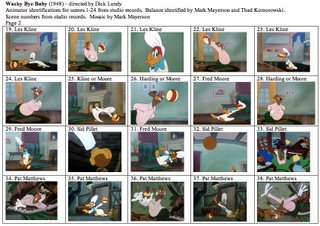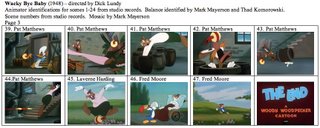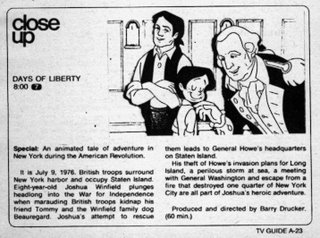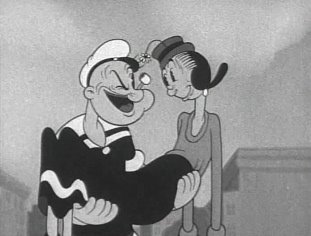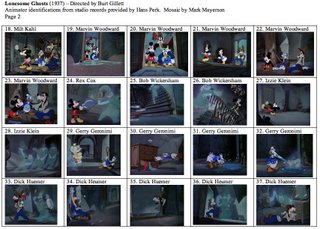Before getting to that, though, I want to mention some interesting layout. Paul Teolis wrote me about Zach Schwartz teaching the dragon's introductory sequence at Sheridan and talking about how free the layout artists were with changing geography as needed. If you look at scene 20, you can see that the mound that the boy is sitting on is near a rock formation that forms a shower. Yet when the dragon dances past the boy in scene 43, that rock formation has vanished! In fact, once the dragon leaves the shower, the backgrounds are some of the sparest you'll find in a Disney feature.
Director Ham Luske definitely cast the animators by character here. In sequence 12.2, Woolie Reitherman does all of the dragon scenes and in sequence 12.4, the dragon is entirely by Ward Kimball. We usually associate Kimball with broad, comic animation, but the truth is that Reitherman's work here is far broader. Reitherman gets the honor of introducing the dragon and absolutely nails the character's personality. We thoroughly know this dragon by the time Reitherman gets done with him.
Reitherman had sort of a split personality as an animator. On the one hand, he was known for realistic, powerful action while doing characters like Monstro in Pinocchio and the dinosaurs in the "Rite of Spring" segment of Fantasia. On the other hand, he often animated Goofy, such as Goofy attempting to surf in Hawaiian Holiday. This dragon is much closer to Goofy than the Fantasia dinosaurs.
By contrast, Kimball's dragon is much more subtle. It's true that the dragon stays seated in one spot for the whole sequence and the dragon's nonchalance has to contrast with the boy's panic, but it's interesting that somebody chose to put Kimball on this sequence. His animation works fine, but his opportunites are fairly limited.
Paul Murry does a few scenes of the boy. I know that Murry has many fans of his comic book work. For years, he did the Mickey serials at the back of Walt Disney's Comics and Stories. Here's an example from issue 185 from 1956.
 I have to admit that I'm not a fan of Murry's comic book work. It always seemed lumpy and ungainly to me. He handles the animation of the boy well, but seems to have trouble with the boy's hair. It's not a great hair design, but in Murry's scenes it sometimes looks a little like a loose wig. I do have to say, though, that the boy turning around in scene 25 is a lovely piece of animation.
I have to admit that I'm not a fan of Murry's comic book work. It always seemed lumpy and ungainly to me. He handles the animation of the boy well, but seems to have trouble with the boy's hair. It's not a great hair design, but in Murry's scenes it sometimes looks a little like a loose wig. I do have to say, though, that the boy turning around in scene 25 is a lovely piece of animation.Walt Kelly's scenes of the boy provide him with better acting opportunities than the Mickey shorts I covered in earlier entries. Kelly seems to have some trouble with the boy's hair as well, but he does keep it rooted. Scene 23 is an original solution to the motion of sitting down. The acting in scenes 35, 41 and 42.1 is very nice. Kelly had a real talent for posing in the Pogo comic strip and it appears that it was developed while he was at Disney.
One interesting thing is that Kelly's runs and walks are lacking. The run in scene 15.1 is weightless and the walk in scene 26 puts more effort into slamming the lead foot onto the ground than in pushing off with the rear foot.
Kelly definitely showed promise as an animator, but the strike cut his career short and he went into comics for the balance of his life. He did try his hand animating one more time late in life when he and Selby created the Pogo animated short We Have Met the Enemy and He is Us around 1970. By that time, Kelly's timing was rusty and some of the animation could have used more inbetweens, but Kelly's animation skills hadn't deserted him.
Last, and never least, is Fred Moore. Moore does the excellent work you'd expect from him on the boy (though even Moore seems to struggle with the hair), but the revelation here is Moore's Sir Giles. We associate Moore with round, soft shapes, whether mice, pigs or girls. Giles is thin and angular. As a design, he doesn't play to Moore's strengths, yet Moore clearly has fun with Giles lanky form. In scene 21, he gets some great poses out of Giles bathing in the tiny bucket. In scene 27, when Giles says "Preposterous!" Moore really pushes the facial expressions for comic effect.
Moore nails Sir Giles and the boy the way Reitherman nailed the dragon. And in this sequence between the two of them, Moore plays them off each other beautifully. Ham Luske knew what he was doing when he assigned these two animators to the three star characters' entrances. By the time this sequence is finished, we know there's a confrontation coming and we can't wait to see how it plays out.






